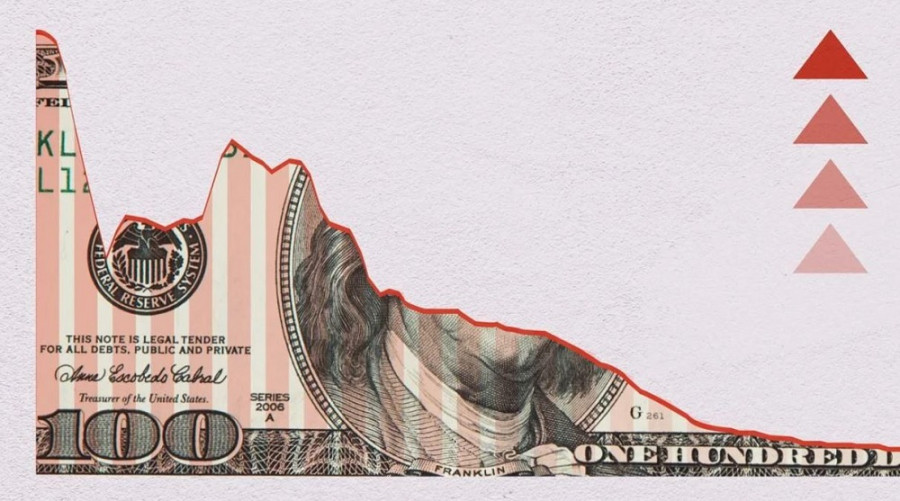The EUR/USD pair sharply traded higher on Wednesday while the economic calendar was nearly empty, firmly staying within the 1.11 figure. The bulls easily surpassed the resistance level at 1.1060 (the Tenkan-sen line on the 4-hour chart) and are testing the price barrier at 1.1130 (the upper line of the Bollinger Bands indicator on the daily chart). The last time the pair was in this area was in July.
Such price dynamics are not only due to the greenback's weakness. In this case, the euro plays a secondary but not insignificant role.
The U.S. Dollar Index continues to plummet, returning to the 100 figure on Thursday, and it seems that it will plunge below the hundredth level in the near future. Major dollar pairs have adjusted their configuration accordingly. So why has the dollar fallen sharply on all fronts?

First and foremost, it's important to remember that in thin market conditions, we have often seen such price spikes (or declines). Amid a semi-empty economic calendar, the pair either sharply gains momentum or, conversely, plunges into the abyss. Even a secondary economic report can become the trigger for such price movements.
This is what happened this time as well. During the US session on Wednesday, the Federal Reserve Bank of Richmond's manufacturing index, based on a survey of manufacturing companies in the region (including the state of Maryland, the District of Columbia, Virginia, North Carolina, South Carolina, and much of West Virginia), was published. In most cases, this index has limited impact on the market, but on Wednesday, it triggered strong volatility. According to preliminary forecasts, the index was expected to decrease to -4 points. However, in reality, it plummeted to -11 points, hitting a 6-month low.
I'll repeat: the index itself is secondary - it is usually overshadowed by more significant economic reports. But this report was the only release during the US session. Therefore, it, so to speak, led to more extensive reflections, the essence of which boils down to the widening divergence in the policies of the Fed and the European Central Bank.
The market's dovish sentiment regarding the Fed's future course of actions continues to grow. For instance, the probability of a 25-point rate cut at the outcome of the next - January - meeting is almost 20% (according to CME FedWatch Tool data). The probability of a 25-point cut at the March meeting is 75%. At the same time, the market assigns a 15% probability that the Fed will reduce the rate by 50 points at once. Traders also estimate a 66% probability of a rate cut to 4.75% after the June meeting.
The decline in Treasury yields also exert pressure on the greenback. For instance, the yield on 10-year US government bonds is currently at 3.81% (on Wednesday, this figure fell to 3.78%).
Meanwhile, the ECB continues to provide background support for the euro. Another ECB representative signaled hawkish rhetoric, joining the chorus of like-minded officials. Robert Holzmann, the head of the Austrian central bank, said that the current monetary policy is already showing its impact on slowing down inflation, "but it would still be premature to think about rate cuts,". However, the most important point he added is that there are actually no guarantees that the ECB will ease monetary policy next year, "even if the ECB is past an unprecedented series of ten consecutive rate increases,".
So, we have two messages here. First, Holzmann questions the rate cuts in 2024 (ECB President Christine Lagarde said that rates would remain at their current level "at least in the first half of next year"). Second, Holzmann hypothetically allowed for another round of rate hikes.
Comments from this ECB official should be considered in the context of statements from some of his colleagues (including Philip Lane, Joachim Nagel, Luis de Guindos, Yannis Stournaras). They have also denied rumors that the ECB will start discussing the terms of easing monetary policy in the near future.
Thus, the fundamental background continues to support the development of the uptrend - even in the conditions of a thin market. The difference between the ECB and the Fed's policies work in favor of the bulls.
This is also evident in the technical analysis. On all higher time frames (from 4H and above), the pair is either at the upper or between the middle and upper lines of the Bollinger Bands indicator. In addition, on the daily and weekly charts, the Ichimoku indicator has formed one of its strongest bullish signals, the Parade of Lines. Therefore, it is advisable to use any corrective pullbacks for opening long positions. The target of the bullish movement is the level of 1.1250 - this is the upper line of the Bollinger Bands indicator on the MN timeframe.
The material has been provided by InstaForex Company - www.instaforex.comfrom Forex analysis review https://ift.tt/otdx8BV
via IFTTT
